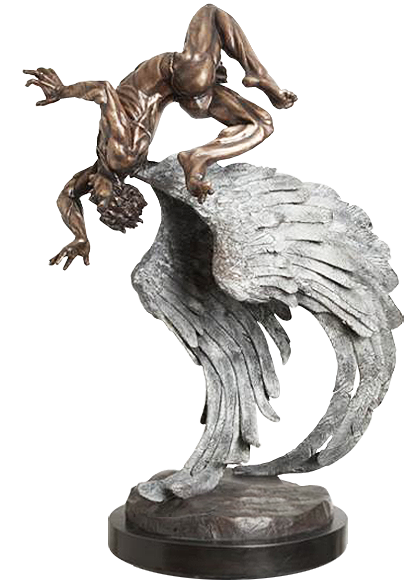Tall Bronze
on Circular Base
110cm high x 60cm x 60cm, 3 ft 6 in high x 2 ft x 2 ft
Special Mixed
Patination
(1)
Icarus: Classic Potash. Rich Medium
and Dark Brown, with Golden undertone.
(2)
Wings: Mixture of Brown Potash and
White Flakes, with White undertone.
(3)
Sea: Dark Brown Potash.
Circular Base (50cm x 50 cm / 20in x 20in) (Turntable inside so
viewer can easily turn it 360º)
CLASSICAL MYTHOLOGY:
Man’s First
Flight. The
famous Greek inventor, Daedalus, and his son, Icarus, were captive
in the unroofed Labyrinth. Since their only means of escape was by
air, Daedalus made two pairs of wings out of feathers and wax. He
told Icarus neither to fly too near the sun, which would melt the
wax, nor too close to the sea, which would wet the feathers. But
Icarus, exalting in the freedom of the air, forgot his wise father’s
words and flew ever higher, until the sun melted the wax and he
plummeted to his death in the sea below. The Icarian Sea, where he
fell, was named after him.
SCULPTURE’S
DESCRIPTION:
For 3000 years,
artists and sculptors have utilized the best of their skills to
project their interpretation of the legendary flight of Daedalus and
Icarus and the eventual fall of Icarus. Richard Minns, at 81 and the
height of his artistic powers, has now entered the classics arena
with his interpretation: first, with his award-winning masterpiece
Flying Too High (Daedalus and Icarus) and now with the companion
piece 'Icarus’ Final Moment'.
Richard
normally employs the classic potash rich medium and dark brown
patina used by the Old Masters. But this time his sculpture has a
very contemporary look. Icarus is in classic potash but this time
there is an undercoating of gold, which is covered by the classic
potash, but when a light dances across his body, Icarus will take on
a golden glow.
The wings are
set apart, with a mixture of brown potash with white flakes and
white undertones. As the light changes, the wings and the individual
feathers turn white and they become alive!
ARTIST’S INTERPRETATION:
“The story of
Daedalus and Icarus, the Greek’s classic prodigal son story, as well
as man’s first attempt to fly, has always been one of my favorite
Greek myths. I have done many “sketches” of Icarus over the years
and you will find them throughout my notepads and my drawing
pads. It seems that I’ve been training to do this sculpture all my
life. I love the challenge of portraying a beautiful young
perfectly-developed male body, hanging in space, with every muscle
strained to the limit.”
“Icarus
was sculpted and modeled in plasticina. The Wings were done in wax,
using the same technique I used on my large bronze relief “The Eagle
Soars” (Jupiter’s Messenger). Every feather was sculpted and modeled
to perfection. Then when the wings were absolutely perfect, and in
the right position, I slowly destroyed them, dripping melted wax all
over them. Great Fun!”
“I hope you enjoy this
sculpture only half as much as I enjoyed creating it”.
Richard Minns
 home
about
artists
exhibitions
press
contact
purchase
home
about
artists
exhibitions
press
contact
purchase



